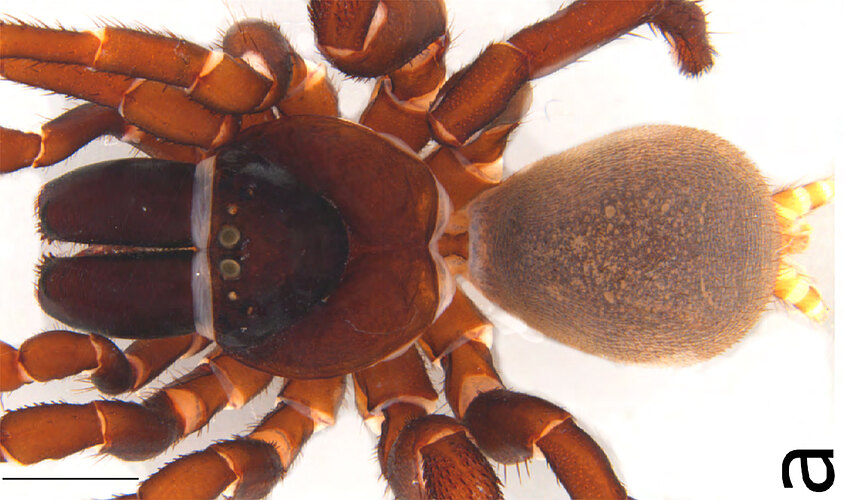Durokoppin Mouse Spider Missulena durokoppin Marsch, Stevens & Framenau, 2023
Fauna Portal species: 12675Diagnosis
(after Marsh et al. 2023): Males of M. durokoppin are similar to seven other species, which share a brown carapace and chelicerae: Missulena faulderi, M. harewoodi, M. leniae, M. melissae, M. pinguipes, M. rutraspina, and M. terra. Of these, they differ from M. terra, M. harewoodi, M. melissae and M. pinguipes by having a slender pedipalp tibia as opposed to it being distinctly swollen in these other species. Males of M. durokoppin differ from males of other species by the number of spinules in patella III, with 70–100 covering the dorsal, prolateral and retrolateral surface in M. durokoppin, 40 in M. harewoodi, 59 in M. melissae, 42 in M. rutraspina, 41 in M. terra and 31 or fewer in M. faulderi, M. leniae, and M. pinguipes. They are further differentiated from M. leniae and M. rutraspina by having a smooth carapace, which is coarsely granulated in males of these other species. They are further separated from males of M. faulderi by the curvature of the embolus, which is straighter and less curved in M. durkoppin. Males of M. durokoppin further differ from males of M. pinguipes by the number of spines in the rastellum, with five strong spines in M. durokoppin, as opposed nine in M. pinguipes.
Status
- native
Linnean Holotype
Australia
- Western Australia
Fauna Portal Records
The map shows all records that have been verified as part of the Fauna Portal project and may not represent the true distribution of a species. Specifically, for described species, check the link to the Atlas of Living Australia on this page for potential wider distributions. Fauna Portal Reference specimens and Linnean types are shown in red. If you identified a specimen that exceeds the distribution of an undescribed species as illustrated here, please contact the Fauna Portal team who can assist with the lodgement of the specimen in a public institution and display on the map.
Publications
Araneae (Spiders)
- Actinopodidae
- Anamidae
- Araneae fam. indet.
- Araneidae
- Archaeidae
- Argyronetidae
- Arkyidae
- Barychelidae
- Cheiracanthiidae
- Clubionidae
- Corinnidae
- Cycloctenidae
- Deinopidae
- Desidae
- Dictynidae
- Filistatidae
- Gnaphosidae
- Halonoproctidae
- Hersiliidae
- Idiopidae
- Lamponidae
- Linyphiidae
- Lycosidae
- Mimetidae
- Miturgidae
- Mysmenidae
- Nicodamidae
- Oecobiidae
- Oonopidae
- Oxyopidae
- Philodromidae
- Pholcidae
- Pisauridae
- Prodidomidae
- Salticidae
- Scytodidae
- Segestriidae
- Selenopidae
- Sparassidae
- Symphytognathidae
- Tetrablemmidae
- Tetragnathidae
- Theridiidae
- Thomisidae
- Trachelidae
- Trachycosmidae
- Trochanteriidae
- Uloboridae
- Zodariidae
- Zoropsidae
All classes
- Arachnida
- Crustacea
- Entognatha
- Gastropoda
- Insecta
- Orthoptera - Caelifera (Grasshoppers)
- Hymenoptera excl. Formicidae (bees and wasps)
- Blattodea s. str. (Cockroaches)
- Coleoptera (Beetles)
- Dermaptera (earwigs)
- Diptera (flies, mosquitos)
- Entomobryomorpha (slender springtails)
- Hemiptera - Heteroptera (True Bugs)
- Hemiptera - Sternorrhyncha (aphids, scales etc.)
- Hemiptera - Auchenorrhyncha (cicadas, planthoppers)
- Hymenoptera - Formicidae (Ants)
- Trichoptera (Caddisflies)
- Zygentoma (silverfish)
- Myriapoda

